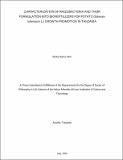| dc.description.abstract | Rhizobacteria and their plant growth-promoting (PGP activities have widely been investigated as
biofertilizers for many crops but rarely for the potato (Solanum tuberosum L.). In the present
study, potato-grown soils from three agro-ecological zones in Tanzania were sampled,
characterized, and a total of 145 rhizobacteria isolated from them. The isolates were screened in
vitro for PGP activities like nutrients solubilization, nitrogen fixation, and phytohormones
production, and 52 most-promising isolates were characterized and identified by 16S-rRNA
sequencing. Their effects on pot-grown potatoes were evaluated against non-inoculated plants as
controls. Klebsiella grimontii MPUS7, Serratia marcescens NGAS9, and Citrobacter freundii
LUTT5 were selected based on their effects on pot-grown potatoes and formulated in different
carrier materials as possible biofertilizers. Their shelf lives were determined as colony-forming
units (CFU) under refrigerated (8
o
C) and room conditions (25 ± 2
o
C) for eight months and their
effects on field-grown potatoes evaluated against recommended fertilizers and non-treated
plants. Data analysis involved XLSTAT (2.3). Significant differences (p ≤ 0.05) were evident for
the fertility-related properties of the sampled soils but not their nutrient contents. Though slightly
acidic (pH < 6.5), non-saline (Electrical conductivity < 1 dS m
-1
), and greater proportions of silt
+ clay (average 46.85 ± 15.18%) than gravel and sand, the soils contained low nutrient levels
which may not be ideal for potato production. The rhizobacteria significantly differed in their invitro
PGP
activities.
Except
for
the
number
of
days
to
emergence
and
flowering,
rhizosphere
soil
pH,
and salinity, potato growth-related parameters like tuber numbers, sizes, weights, and
nutrient contents were enhanced by the rhizobacterial treatments in the screen house by up to
90%. The PM-1 formulation supported the maximum K. grimontii MPUS7 growth (5.3 log-CFU
g
-1
) under refrigeration and C. freundii LUTT5 (4.1 log-CFU g
-1
) under refrigerated and room
conditions but the highest K. grimontii MPUS7 population (3.7 log-CFU g
-1
) was realized in
room-stored PM-4. The formulations also showed varied activities at enhancing potato growth
and most had similar or greater effects on potato growth as the artificial fertilizers and can
effectively be used to replace the use of synthetic fertilizers in potato production systems in
Tanzania. | en_US |

